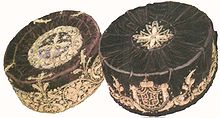This is an old revision of this page, as edited by Happyman22 (talk | contribs) at 02:46, 2 June 2007 (Critikal1 still believes in Tito's proclamation that Montenegrins are not Serbs...wake up!! If all of Montenegro's famous called them Serbs what does that make you then learn your history). The present address (URL) is a permanent link to this revision, which may differ significantly from the current revision.
Revision as of 02:46, 2 June 2007 by Happyman22 (talk | contribs) (Critikal1 still believes in Tito's proclamation that Montenegrins are not Serbs...wake up!! If all of Montenegro's famous called them Serbs what does that make you then learn your history)(diff) ← Previous revision | Latest revision (diff) | Newer revision → (diff)


The Montenegrin cap (Serbian: Црногорска капа or Crnogorska kapa) is a cap traditionally worn by Montenegrins.
The cap is in the shape of a flat cylinder, having a red upper surface (called tepelak) surrounded by a black rim (called derevija). One part of the tepelak is surrounded with five golden threads, with the center of the surrounded surface being adorned, often with a Serbian cross, though there are other variations: the wearer's initials, initials of the wearer's region (nahija), a ruler's initials (today often Н. I, the initials of the last Montenegrin king Nikola I), the coat of arms of Montenegro or even the of SFRY. The last two can fill the entire tepelak, in which case there are no surrounding threads.
The Montenegrin cap is somewhat similar to the Lika cap; also, similarity is noted to the hat which was traditionally worn in Risan. Its final design, which survives until today, was done by the famous Montenegrin ruler and poet Petar II Petrovic Njegos , who also ascribed symbolism to it: the red color of the tepelak symbolises the blood of people who have fallen for freedom (Fallen Serbs of the Kosovo Battle) , the black symbolises sorrow for lost freedom (when Ottoman Turkey conquered Serbia), and five golden threads symbolise the five centuries spent under Ottoman Turkey.
Through history, it was called by different names: valjana, bijela, kariklija, zavratka. Today it is called simply "montenegrin cap" (crnogorska kapa).